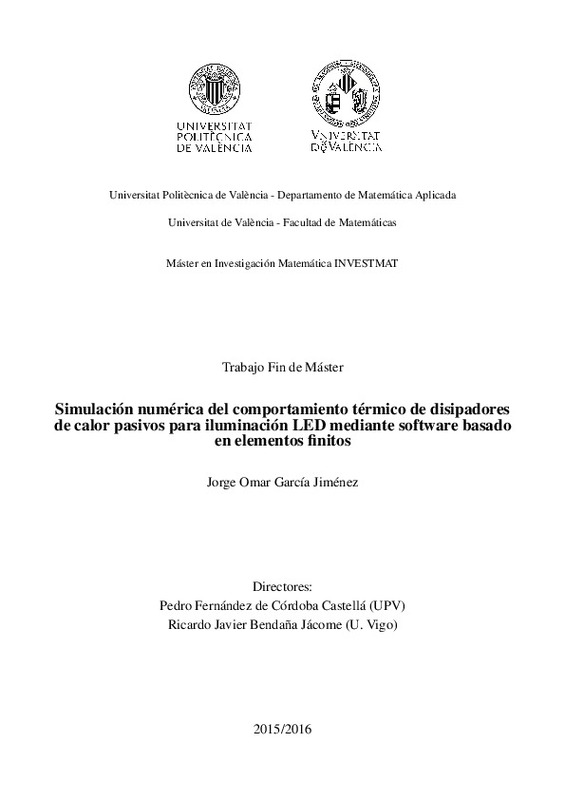JavaScript is disabled for your browser. Some features of this site may not work without it.
Buscar en RiuNet
Listar
Mi cuenta
Estadísticas
Ayuda RiuNet
Admin. UPV
Simulación numérica del comportamiento térmico de disipadores de calor pasivos para iluminación LED mediante software basado en elementos finitos
Mostrar el registro sencillo del ítem
Ficheros en el ítem
| dc.contributor.advisor | Fernández de Córdoba Castellá, Pedro José
|
es_ES |
| dc.contributor.advisor | Bendaña Jácome, Ricardo Javier
|
es_ES |
| dc.contributor.author | García Jiménez, Jorge Omar
|
es_ES |
| dc.date.accessioned | 2016-07-29T09:03:52Z | |
| dc.date.available | 2016-07-29T09:03:52Z | |
| dc.date.created | 2016-07-13 | |
| dc.date.issued | 2016-07-29 | es_ES |
| dc.identifier.uri | http://hdl.handle.net/10251/68429 | |
| dc.description.abstract | [EN] The aim of this work is to find possible improvements in the design of heat sinks for LED chips. A numerical thechnique known as finite element method will be used to simulate the heat transfer and to find the working temperature which is the critical point that determines the life length of the LED chip. To do this a different design software, from the initialy used, will be implemented. Additionally, a comparison between the results generated by the SOLIDWORKS ¿ (new simulation) and the ones generated by COMSOL Multiphysics ¿ (original simulation) will be performed. Finally, using one of the tools provided by SOLIDWORKS¿ software, optimization tool, we want to analyze the different geometries, using parametric modeling, recommended by the software to find the optimum design of the heat sink. | es_ES |
| dc.description.abstract | [ES] El objetivo del trabajo es encontrar posibles mejoras en el diseño de disipadores de calor para obleas LED. Se utilizarán métodos numéricos de elementos finitos para simular la transmisión de calor y encontrar la temperatura de trabajo que es el punto crítico que determina la vida útil del chip LED. Para esto se implementará un software diferente al utilizado inicialmente en el diseño del disipador. Adicionalmente, se realizará una comparación entre el resultado generado por el SOLIDWORKS ¿ (simulación nueva) y el generado por COMSOL Multiphysics ¿ (simulación original). Finalmente, utilizando una de las herramientas que brinda el programa SOLIDWORKS¿, herramienta de optimización, se desea analizar las diferentes geometrías, mediante el modelado paramétrico, recomendadas por el programa para buscar el diseño óptimo del disipador de calor. | es_ES |
| dc.language | Español | es_ES |
| dc.publisher | Universitat Politècnica de València | es_ES |
| dc.rights | Reserva de todos los derechos | es_ES |
| dc.subject | LED | es_ES |
| dc.subject | Finite Elements | es_ES |
| dc.subject | Heat sink | es_ES |
| dc.subject | Elementos finitos | es_ES |
| dc.subject | Disipador de calor. | es_ES |
| dc.subject.classification | MATEMATICA APLICADA | es_ES |
| dc.subject.other | Máster Universitario en Investigación Matemática-Màster Universitari en Investigació Matemàtica | es_ES |
| dc.title | Simulación numérica del comportamiento térmico de disipadores de calor pasivos para iluminación LED mediante software basado en elementos finitos | es_ES |
| dc.type | Tesis de máster | es_ES |
| dc.rights.accessRights | Abierto | es_ES |
| dc.contributor.affiliation | Universitat Politècnica de València. Departamento de Matemática Aplicada - Departament de Matemàtica Aplicada | es_ES |
| dc.description.bibliographicCitation | García Jiménez, JO. (2016). Simulación numérica del comportamiento térmico de disipadores de calor pasivos para iluminación LED mediante software basado en elementos finitos. http://hdl.handle.net/10251/68429 | es_ES |
| dc.description.accrualMethod | TFGM | es_ES |
| dc.relation.pasarela | TFGM\47261 | es_ES |






